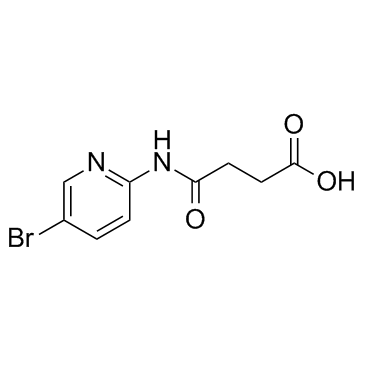Bikinin

Bikinin structure
|
Common Name | Bikinin | ||
|---|---|---|---|---|
| CAS Number | 188011-69-0 | Molecular Weight | 273.083 | |
| Density | 1.7±0.1 g/cm3 | Boiling Point | 521.6±45.0 °C at 760 mmHg | |
| Molecular Formula | C9H9BrN2O3 | Melting Point | 144°C(lit.) | |
| MSDS | Chinese USA | Flash Point | 269.2±28.7 °C | |
| Symbol |

GHS07 |
Signal Word | Warning | |
Use of BikininBikinin is a non-steroidal, ATP-competitive inhibitor of plant GSK-3/Shaggy-like kinases and activates BR (brassinosteroids) signaling. |
| Name | 4-[(5-bromopyridin-2-yl)amino]-4-oxobutanoic acid |
|---|---|
| Synonym | More Synonyms |
| Description | Bikinin is a non-steroidal, ATP-competitive inhibitor of plant GSK-3/Shaggy-like kinases and activates BR (brassinosteroids) signaling. |
|---|---|
| Related Catalog | |
| Target |
GSK-3 |
| In Vitro | Bikinin reduces transcript levels of NbRBOHB and BR-induced NbRBOHB expression in TRV:00, TRV:NbDWARF, TRV:NbBRI1, TRV:NbBSK1, TRV:NbBAK1, TRV:NbBIK1 and TRV:NbBSU1 plants. Bikinin largely inhibits BR-increased ROS accumulation. Moreover, Bikinin decreases the transcripts of these six genes in all plants, but fails to down-regulate transcripts of these genes in NbBES1/BZR1-silenced plants. Bikinin also inhabits BR-induced up-regulation of the six genes, and the inhibition effects are compromised in NbBES1/BZR1-silenced plants[1]. Bikinin is a potent inhibitor of group I and group II ASKs[2]. Bikinin directly binds the GSK3 BIN2 and acts as an ATP competitor. Furthermore, bikinin inhibits the activity of six other Arabidopsis GSK3s[3]. |
| Kinase Assay | ASKs are expressed as GST-fusion proteins in Escherichia coli BL21. In vitro kinase assays are performed by incubating 50 ng GST-fusion protein, 10 μg myelin basic protein (MBP) as a substrate and 0.15 MBq γ-[32P]-ATP as co-substrate at 25°C for 30 min. The reaction buffer consists of 20 mM HEPES/KOH pH 7.4, 15 mM MgCl2, 5 mM EGTA, 1 mM dithiothreitol and 1 μM cold ATP. The reaction products are separated by SDS-PAGE and the amount of radioactivity incorporated into MBP quantified using an Amersham storage phosphor imager screen and a Biorad Molecular Imager FX[2]. |
| References |
| Density | 1.7±0.1 g/cm3 |
|---|---|
| Boiling Point | 521.6±45.0 °C at 760 mmHg |
| Melting Point | 144°C(lit.) |
| Molecular Formula | C9H9BrN2O3 |
| Molecular Weight | 273.083 |
| Flash Point | 269.2±28.7 °C |
| Exact Mass | 271.979645 |
| PSA | 79.29000 |
| LogP | 1.73 |
| Appearance of Characters | white to tan |
| Vapour Pressure | 0.0±1.4 mmHg at 25°C |
| Index of Refraction | 1.635 |
| Storage condition | 2-8°C |
| Water Solubility | DMSO: ≥5mg/mL |
| HS Code | 2933399090 |
|---|---|
| Summary | 2933399090. other compounds containing an unfused pyridine ring (whether or not hydrogenated) in the structure. VAT:17.0%. Tax rebate rate:13.0%. . MFN tariff:6.5%. General tariff:20.0% |
|
BR-dependent phosphorylation modulates PIF4 transcriptional activity and shapes diurnal hypocotyl growth.
Genes Dev. 28(15) , 1681-94, (2014) Signaling by the hormones brassinosteroid (BR) and gibberellin (GA) is critical to normal plant growth and development and is required for hypocotyl elongation in response to dark and elevated tempera... |
|
|
Chemical inhibition of a subset of Arabidopsis thaliana GSK3-like kinases activates brassinosteroid signaling.
Chem. Biol. 16 , 594-604, (2009) Glycogen synthase kinase 3 (GSK3) is a key regulator in signaling pathways in both animals and plants. Three Arabidopsis thaliana GSK3s are shown to be related to brassinosteroid (BR) signaling. In a ... |
| 4-[(5-bromopyridin-2-yl)amino]-4-oxobutanoic acid |
| 4-[(5-bromo-2-pyridyl)amino]-4-oxobutanoic acid |
| 4-[(5-Bromo-2-pyridinyl)amino]-4-oxobutanoic acid |
| Butanoic acid, 4-[(5-bromo-2-pyridinyl)amino]-4-oxo- |
| Butanoic acid,4-[(5-bromo-2-pyridinyl)amino]-4-oxo- |
| Bikinin |

